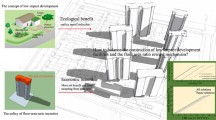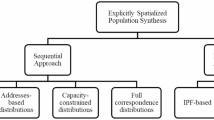Abstract
This article examines where and how to impose floor area ratio (FAR) regulations in the presence of negative externalities engendered in population density, e.g., traffic congestion and noise, using a simple static closed city model. Results indicate that FAR regulation is the second-best policy and that there is a need for “minimum FAR regulations,” in addition to the currently used “maximum FAR regulations.” Thus, the imposition of only maximum FAR regulations, a practice common in actual city planning, is concluded to be insufficient for a closed city.
Similar content being viewed by others
Explore related subjects
Discover the latest articles and news from researchers in related subjects, suggested using machine learning.References
Arnott RJ, MacKinnon JG (1977) Measuring the costs of height restrictions with a general equilibrium model. Reg Sci Urban Econ 7: 359–375. doi:10.1016/0166-0462(77)90005-9
Bertaud A, Brueckner JK (2005) Analyzing building-height restrictions: predicted impacts and welfare costs. Reg Sci Urban Econ 35: 109–125. doi:10.1016/j.regsciurbeco.2004.02.004
Brueckner JK (1990) Growth controls and land values in an open city. Land Econ 66: 237–248. doi:10.2307/3146726
Brueckner JK, Lai F-C (1996) Urban growth controls with resident landowners. Reg Sci Urban Econ 26: 125–143. doi:10.1016/0166-0462(95)02125-6
Courant PN (1976) On the effect of Fiscal zoning on land and housing values. J Urban Econ 3: 88–94. doi:10.1016/0094-1190(76)90061-9
Fujita M (1989) Neighborhood externalities and traffic congestion. Urban economic theory. Cambridge University Press, Cambridge, pp 226–270
Grieson E, White JR (1981) The effects of zoning on structure and land markets. J Urban Econ 10: 271–285. doi:10.1016/0094-1190(81)90001-2
Harberger AC (1971) Three basic postulates for applied welfare economics: an interpretive essay. J Econ Lit 9: 785–797
Lai F-C, Yang S-T (2002a) A view on optimal urban growth controls. Ann Reg Sci 36: 229–238. doi:10.1007/s001680200079
Lai F-C, Yang S-T (2002b) Reply to the alternative optimal growth controls. Ann Reg Sci 36: 241–245. doi:10.1007/s001680200081
Moss WG (1977) Large lot zoning, property taxes, and metropolitan area. J Urban Econ 4: 408–427. doi:10.1016/0094-1190(77)90003-1
Pasha HA (1996) Suburban minimum lot zoning and spatial equilibrium. J Urban Econ 40: 1–12. doi:10.1006/juec.1996.0020
Pines D, Weiss Y (1976) Land improvement projects and land values. J Urban Econ 3: 1–13. doi:10.1016/0094-1190(76)90054-1
Sasaki K (2002) Alternative view on optimal urban growth controls. Ann Reg Sci 36: 239–240. doi:10.1007/s001680200080
Sullivan AM (1984) Large-lot zoning as second-best policy. J Reg Sci 24: 581–589. doi:10.1111/j.1467-9787.1984.tb01049.x
Wheaton WC (1998) Land use and density in cities with congestion. J Urban Econ 43: 258–272. doi:10.1006/juec.1997.2043
White MJ (1975) The effect of zoning on the size of metropolitan areas. J Urban Econ 2: 279–290. doi:10.1016/0094-1190(75)90029-7
Author information
Authors and Affiliations
Corresponding author
Electronic Supplementary Material
The Below is the Electronic Supplementary Material.
Rights and permissions
About this article
Cite this article
Kono, T., Kaneko, T. & Morisugi, H. Necessity of minimum floor area ratio regulation: a second-best policy. Ann Reg Sci 44, 523–539 (2010). https://doi.org/10.1007/s00168-008-0269-0
Received:
Accepted:
Published:
Issue Date:
DOI: https://doi.org/10.1007/s00168-008-0269-0




